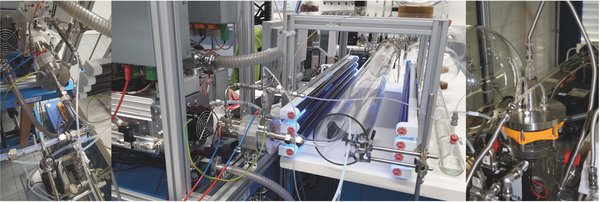
View at different parts of the experimental setup

The detailed understanding of individual oxidation pathways is still a challenging task in atmospheric chemistry. For our laboratory measurements, we are using a free-jet flow system that allows for the investigation of the early stages of an oxidation reaction for atmospheric conditions in the absence of interfering wall effects. This flow system has been developed in collaboration with process engineers, in order to overcome wall loss effects and potential heterogeneous wall reactions, especially of reactive intermediates such as Criegee intermediates and RO2 radicals.

View at different parts of the experimental setup
Direct monitoring of the intermediates and resulting closed-shell products formed in the experiments became possible using chemical ionization mass spectrometry applying a set of different reagent ions. Beside the well-established ionization by means of acetate, CH3COO-, or iodide, I-, recently the utilization of protonated amines and protonated hydrazine has been discovered as an efficient approach for sensitive detection of less oxidized compounds. Further ionization schemes, based on proton transfer reactions, use the protonated compounds of acetic acid, different alcohols, acetone, diethylether or tetrahydrofuran. Achieved detection limits for oxidized compounds are as low as 103 - 104 molecules cm-3, i.e. clearly lower than ppq level (ppq: part-per-quadrillion, 1 / 1015). Reaction conditions can be chosen in such a way that solely the formation of primarily formed RO2 radicals and their unimolecular pathways can be studied.
Dr. Torsten Berndt
Scientific staff